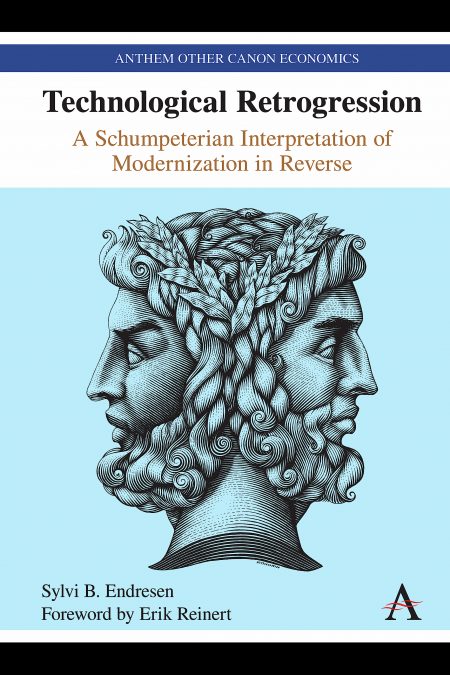Technological Retrogression
A Schumpeterian Interpretation of Modernization in Reverse
Sylvi B. Endresen
foreword by Erik Reinert
Select Format
Title Details
- ISBN: 9781785277139
- June 2021
- Pages: 252
- Imprint: Anthem Press
The aim of this book is to broaden our understanding of technological change by adopting the concept of technological retrogression. With reference to concrete cases of technological retrogression a new conceptual framework is developed. Extensive fieldwork in Sri Lanka and Malaysia forms the empirical fundament. A new method of reconstructing technological change is furthermore developed. The book contains a detailed account of the work history method, which is designed to capture changes over time where there are no statistical data available. The book contains a thorough examination of central theories of socio-economic transitions in developing countries, searching for an explanation of instances where modernization reverses.
The exposition aims at contrasting retrogressive economic dynamics of technological change to progressive dynamics as developed by Schumpeter. At one extreme in the dimension of technological change, capital-strong production units innovate their way out of the recession through technological progress, adopting more advanced production equipment that improves productivity. Following Schumpeterian progressive dynamics, virtuous spirals of growth result. At the other end we find the producers that resort to technological retrogression, which secures survival, but which result in low labour productivity, diminishing the possibility of capital accumulation and thus modernization that could form an escape from poverty. Vicious spirals of decline result, which is the book’s main object of analysis. The theory is, thus, a contribution to understanding the anatomy of recessions.
The contention is, thus, that a choice of technology of production may lead to reduced productivity and economic decline. The concept of technological change should, therefore, not be equated solely with productivity improvements and economic development. Producers who experience technological retrogression may find themselves in the paradoxical situation of earning more by producing less, a paradox which is addressed in this book. Furthermore, where technological retrogression involves a return to organization of production of the past, this may affect the political leverage of labour, curbing social progress. Reversal of modernization, technological and organizational, is linked closely to marginalization of producers and increased social inequality. Lock-in of producers, both technologically and geographically, into activities characterised by diminishing returns, is considered a major precondition of technological retrogression. Therefore, the phenomenon is thought most likely to occur during periods of economic decline, recessions or during prolonged crises.
Sylvi B. Endresen was Associate Professor Emerita at the Department of Human Geography, University of Oslo. Her research is within economic and labour geography.
List of Figures; Foreword by Erik S. Reinert; Acknowledgements; Preface: The Book within This Book; Introduction: The Concept of Technological Retrogression; 1. Challenging Linearity and Irreversibility; 2. Perspectives on Technological Heterogeneity; 3. Production Systems and Work Histories; 4. Empirical Evidence of Technological Retrogression: The Sri Lankan Case; 5. Empirical Evidence of Technological Retrogression: The Malaysian Case; 6. A Theory of Technological Retrogression; References; Index.
“The book is potentially a timely and welcome contribution that goes against the stream in the flood of books on innovation but also on why countries remain poor. It contributes with an evolutionary perspective on the largely ignored phenomenon of technological retrogression, which, in turn, might be a major cause behind continuous falling behind and persistent poverty levels. The message to the development debate is clear – poor countries need to diversify and get their manufacturing sectors going.” —Martin Andersson, Associate Professor, Lund University, Sweden
“The book is potentially a timely and welcome contribution that goes against the stream in the flood of books on innovation but also on why countries remain poor. It contributes with an evolutionary perspective on the largely ignored phenomenon of technological retrogression, which, in turn, might be a major cause behind continuous falling behind and persistent poverty levels. The message to the development debate is clear – poor countries need to diversify and get their manufacturing sectors going.” —Martin Andersson, Associate Professor, Lund University, Sweden
Related products
-
Economic Development of Caricom
From Early Colonial Times to the Present
Winston H. Griffith
October, 2021
£125.00 / $125.00 -
Portuguese and Amsterdam Sephardic Merchants in the Tobacco Trade
Tierra Firme and Hispaniola in the Early Seventeenth Century
Yda Schreuder
January, 2023
£110.00 / $110.00 -
The Military and Denied Development in the Pakistani Punjab
An Eroding Social Consensus
Shahrukh Rafi Khan, Aasim Sajjad Akhtar
with Sohaib BodlaNovember, 2014
£115.00 / $115.00 -
Popular Radicalism and the Unemployed in Chicago during the Great Depression
Chris Wright
June, 2022
£125.00 / $125.00 -
Africa and Economic Policy
Developing a Framework for Policymakers
Ferdinand Bakoup
August, 2014
£115.00 / $115.00 -
Green Growth, Smart Growth
A New Approach to Economics, Innovation and the Environment
Ralf Fücks
foreword by Anthony Giddens
translated by Rachel HarlandJune, 2015
£29.95 / $29.95








